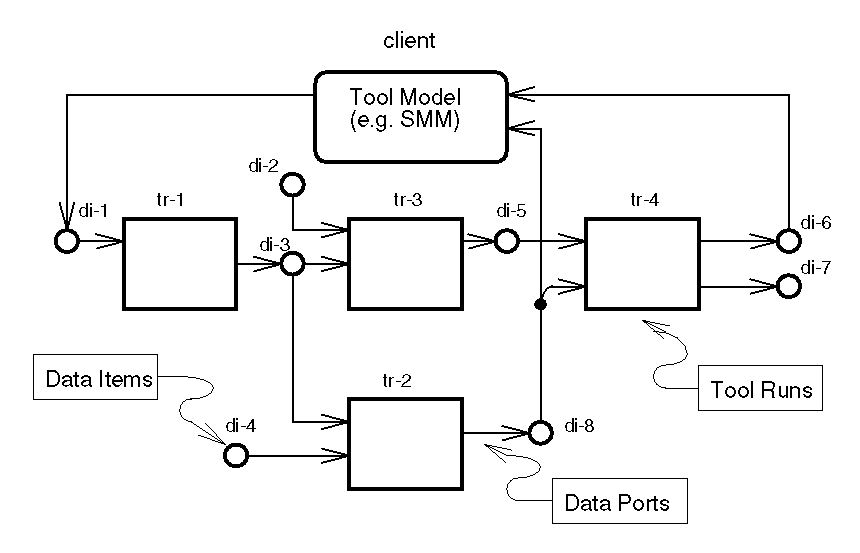Efw - A Prototype Engineering Framework with Graph-based Tool Agents
What is a Framework?
"... an infrastructure of software and interfaces that enable the integration and
interoperability of [engineering] systems" - CFI FAQ
One answer to the question:
"How do we connect people, their models, and their tools?" Olsen [1994]
![[Agent Interaction - People, Models, Tools]](olsen.agent.interaction.gif)
( from
Survey of Engineering Framework Technology, [Peak, 1996] )
Example Framework Objects
- Represent the computing infrastructure of a group or company.
- Enables interaction of "people, their models, and their tools"
-
Users
-
Models (e.g., FEA SMMs)
-
Machines - object wrapper around actual computer.
-
Tools
-
Agents
-
Framework
Typical Analysis Process (e.g., Finite Element Analysis)

Tool Agents
Support highly automated analysis:
-
Take inputs from SMMs.
-
Provide input and control files to solution tools.
-
Run each tool.
-
Give results back to SMMs.
Agent Plans
Agent "work flow diagram" defining
connections between client, data items, and tool runs.
Typical Plan

-
Data Item - Abstracted representation of tool inputs and outputs.
Handles transfers between client and tool runs
Manages and OS files and networking.
-
Tool Run - Indicates usage of a tool.
Manages tool execution.
Examples
Cadas SMM - Plan with FEX/Solver
 Example Plan Instance (usage of a plan)
Example Plan Instance (usage of a plan)

Agent Plans and Graph Theory
An agent plan is a type of
directed acyclic graph (dag)
where vertices are:
-
data items, tool runs, and the client
and edges are:
-
data item usage links and creation links.
Graph Theory Benefits
-
Can define terms and properties more precisely.
Ex. See Tool Plan Capabilities & Limitations.
Ex. Proposition: A tool agent can get results for any
processable tool plan. (not proven yet)
-
Can utilize existing graph algorithms and operations.
Ex. Determine all direct and indirect inputs to tool run #2.
Observations
Characteristics of Computing Environment
(e.g., experiences at AT&T Bell Labs, Hitachi, and Georgia Tech)
-
Highly dynamic (e.g., tool version changes)
-
-
Not well-defined.
-
Present tools are not framework-oriented (but usually ok).
Characteristics of Prototype Framework: Efw
-
Simplified version of work by CFI, NIIIP, etc.
[
Peak, 1996
]
-
Based on File-Oriented Tool-Tool Interaction
-
Good for low tool-tool interaction applications.
-
Typically possible with most existing tools.
-
Primary choice for existing traditional tools.
-
Tool encapsulation process: some methodology, some "art"
-
Other Type of Tool-Tool Interaction: Programmable Interfaces
-
Example: SDRC Open Architecture
-
Good for highly interactive tool-tool applications.
-
Tool encapsulation process: defined methodology
Benefits
-
Fast, highly automated analysis.
-
Repeatable, well-defined analysis tool process.
-
Reduce tedious, error-prone manual tasks.
Costs - "There's no free lunch!"
-
Maintenance of framework data: changes in people, tools, machines, etc.
-
Development effort to produce framework-compatible tools.
Summary - Efw Framework and Agents
-
Demonstrates simple, yet useful, framework technology via
graph-based tool agents.
-
Provides basic framework needs of MRA.
-
Potential Usage: A framework tool for company applications.
-
Use with or without the MRA.
-
Other tools could control Efw, provide inputs, and receive outputs.
-
Use with other types of tools.
-
Supports highly automated analysis.
![[Agent Interaction - People, Models, Tools]](olsen.agent.interaction.gif)
![[Agent Interaction - People, Models, Tools]](olsen.agent.interaction.gif)


 Example Plan Instance (usage of a plan)
Example Plan Instance (usage of a plan)
